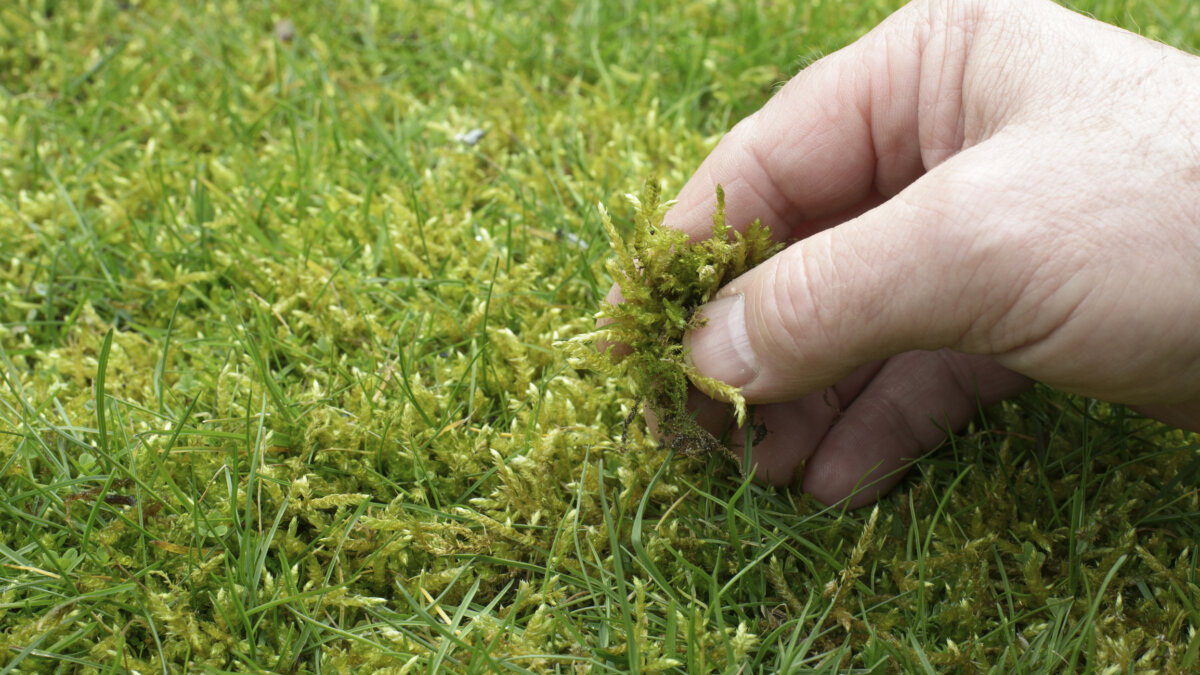
The best moss control strategy is to improve lawn health.
This time of year, we sometimes get calls from our natural lawn care clients wanting to know what to do about moss in the lawn. Moss can be a major problem for lawns in our cool, damp climate.
We tell our clients there are short-term and long-term strategies to manage moss in lawns. In the short term, we can use iron sulphate (see more below). In the long term, the best moss control strategy is to improve the health of the lawn.
We believe we are partners with our clients in building healthy lawns and landscapes. The products we use in our natural lawn care services are aimed at creating the conditions that keep the lawn ecosystem in balance. This starts with feeding the soil. When beneficial critters in the soil thrive, grass plants thrive as well.
But we cannot maintain a healthy lawn if our clients don’t do their part. This means mowing properly. It also means watering the lawn regularly and deeply over the course of the growing season.
 Last year we started Bee Friendly Lawn. Our goal is to educate our clients and others to help save our native bees by keeping the lawn healthy. A healthy, robust lawn is less likely to have problems with moss, weeds, disease and insects.
Last year we started Bee Friendly Lawn. Our goal is to educate our clients and others to help save our native bees by keeping the lawn healthy. A healthy, robust lawn is less likely to have problems with moss, weeds, disease and insects.
Proper lawn care will allow you to greatly reduce and perhaps eliminate the use of products such as moss and weed killer. We will not use weed and moss killer on lawns that are not maintained properly.
Option: Moss control treatment
If our clients request it, we can apply a moss control treatment to the lawn. We use iron sulphate to burn the moss, turning it black. Iron will dehydrate moss but will not kill it. We do not provide moss removal services.
You will need to remove the moss with a thatching rake once it shrivels up and turns black. If it is not removed, it will continue to spread and grow more thickly. You should rake vigorously to loosen the moss and remove it from the lawn. If you have a large lawn, you may want to rent a power rake.
If your lawn has a severe case of moss, raking may leave large bare spots. In this case, we can give you a bid for reseeding, topdressing with compost and applying AxisDE.
Summer watering is important
Moss control treatments will not be successful if you allow your lawn to go dormant in the summer. If your lawn gets too dry, it can get thin and weak. This provides ideal conditions for moss and weeds to invade in the fall when the rains return.
To help your lawn stay healthy, it needs about an inch of water per week. Water once or twice a week, depending on your soil type, not every day. And water slowly and deeply so the lawn develops deep roots. See more about smart lawn watering in this video.
Best moss control strategy: Improving lawn health
The best long-term solution for moss problems is to improve the health of the lawn. Our natural lawn care services will help build the health of the soil and grass plants. But if your lawn has underlying problems or it is in the wrong location, moss will grow better than grass will. You need to address the root causes.
- Compacted soil. If your soil is compacted, it’s tough for grass to grow. Aeration will help your lawn roots gain access to air, water and fertilizer. We are currently aerating lawns for our clients and overseeding to fill in any thin spots.
- Infertile. Your lawn needs nutrients to grow more thickly so it can compete with moss and weeds. We fertilize our clients’ lawns with an organic fertilizer. This feeds the lawn slowly over time. If you mulch mow, it can supply a quarter to half of your lawn’s nitrogen needs.
- Acidic and/or low in calcium. Many soils in western Washington are acidic and may be also be low in calcium. These are poor conditions for lawns. We apply Dolopril lime as needed, which contains both calcium and magnesium.
- Wet. If you have a problem with drainage, you will also have problems with moss. If needed, we could fix drainage onto the lawn from the driveway or sidewalk. We could also alter the slope or fill in low spots that tend to stay wet.
- Shade. Grass needs regular sunlight to grow well. It doesn’t tolerate heavy shade. We can prune your trees to allow more sunlight to reach shady spots and to improve air circulation. The best option for shady areas may be to replace the lawn with a shade garden. Our landscape designers would be happy to work with you to create a garden of shrubs, grasses, ferns and perennials that thrive in the shade.
Contact us if you would like to learn more about our natural lawn care and landscape design and installation services.
